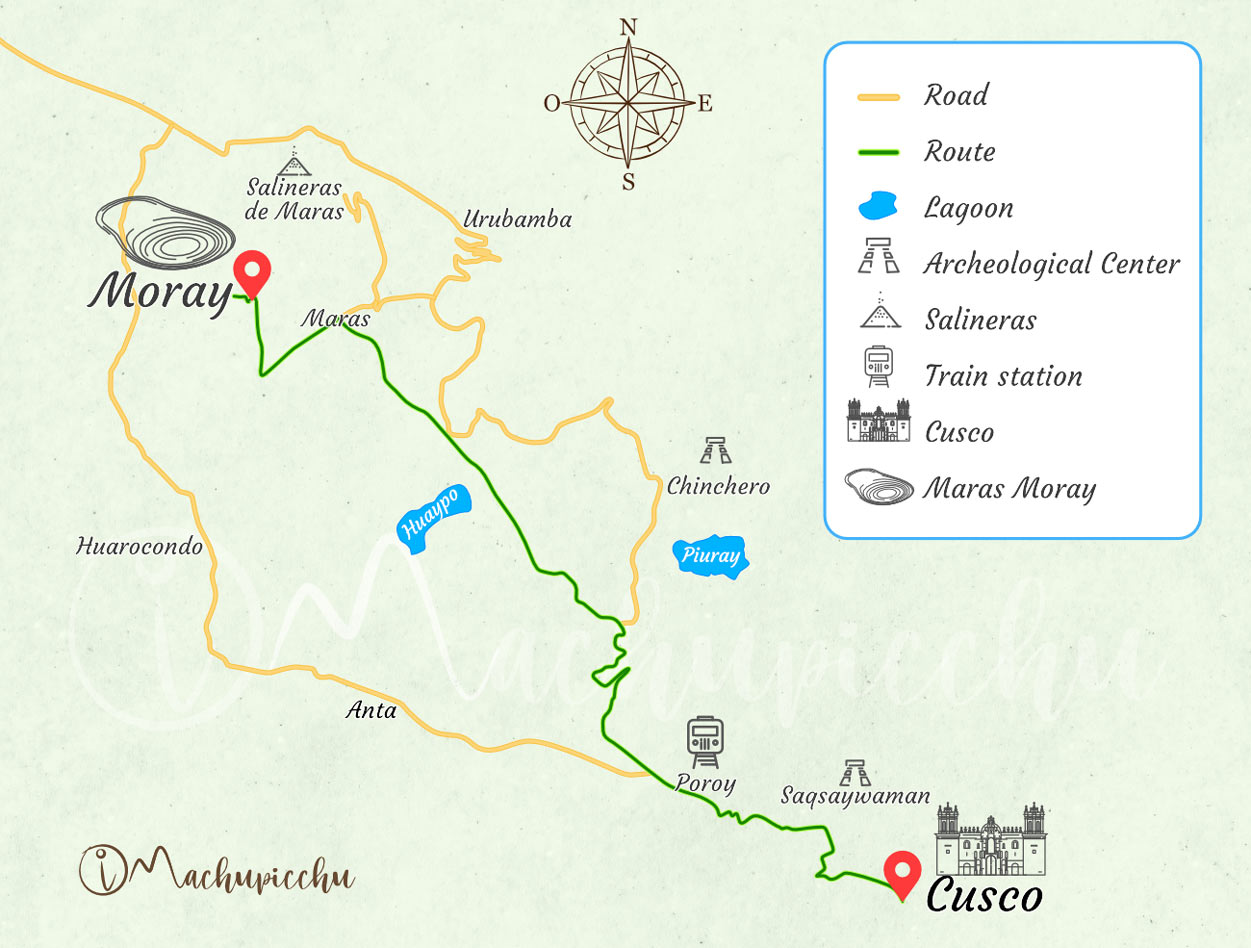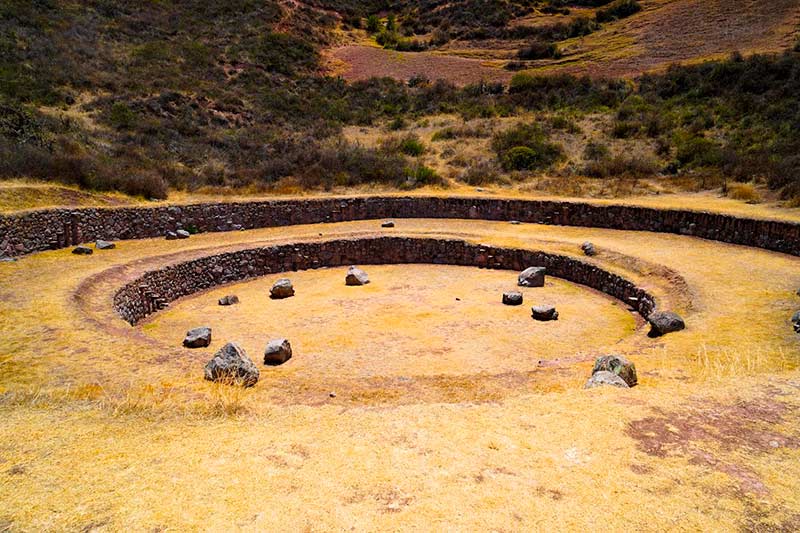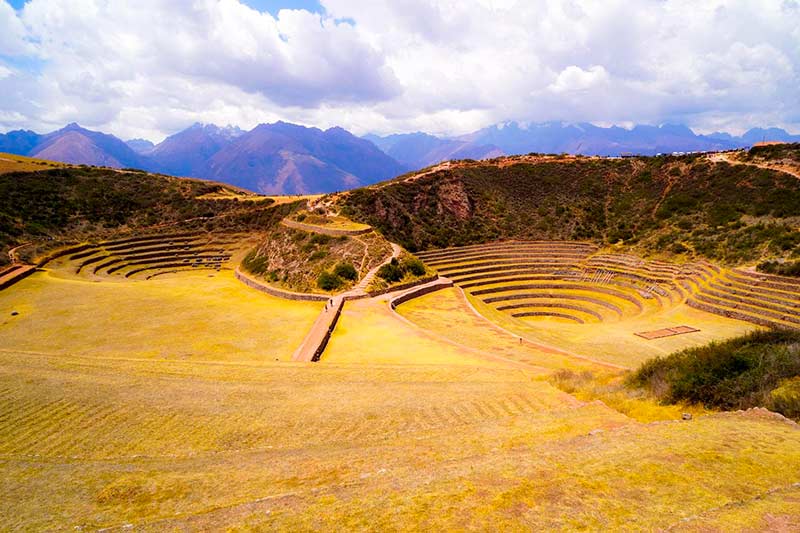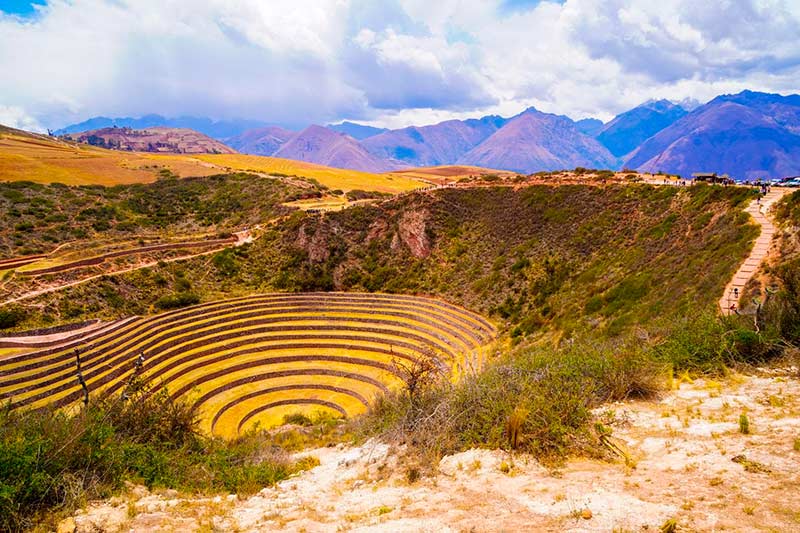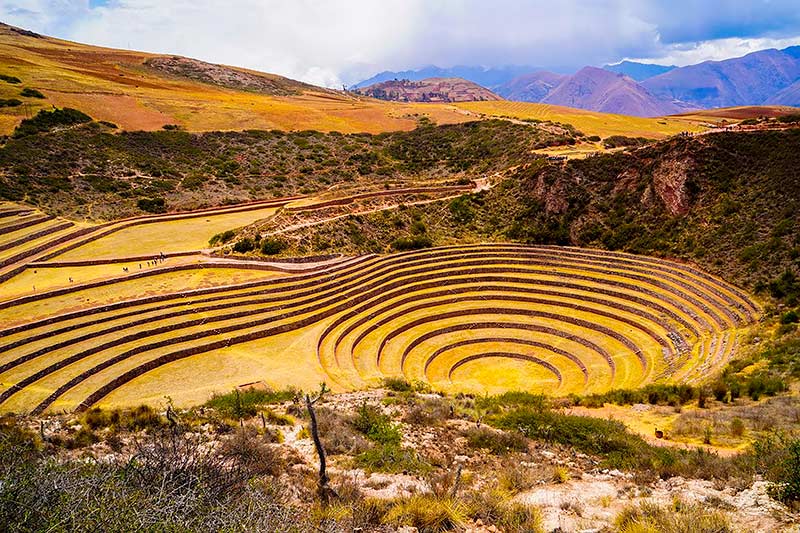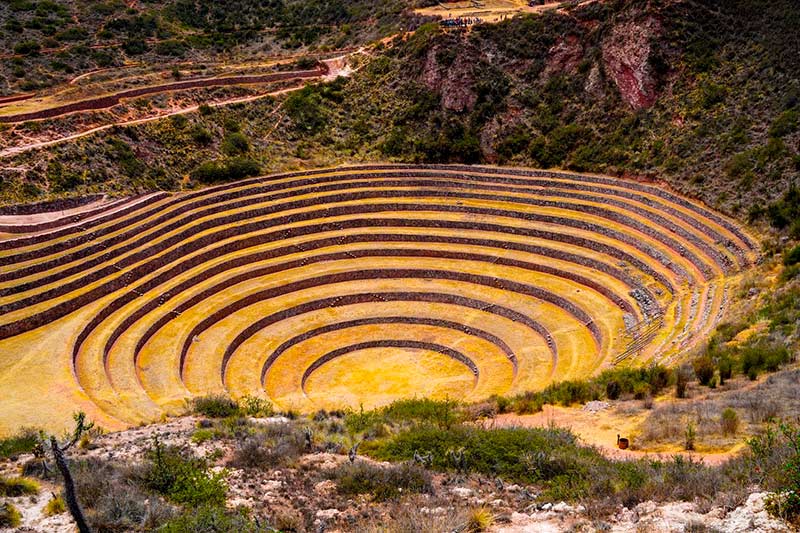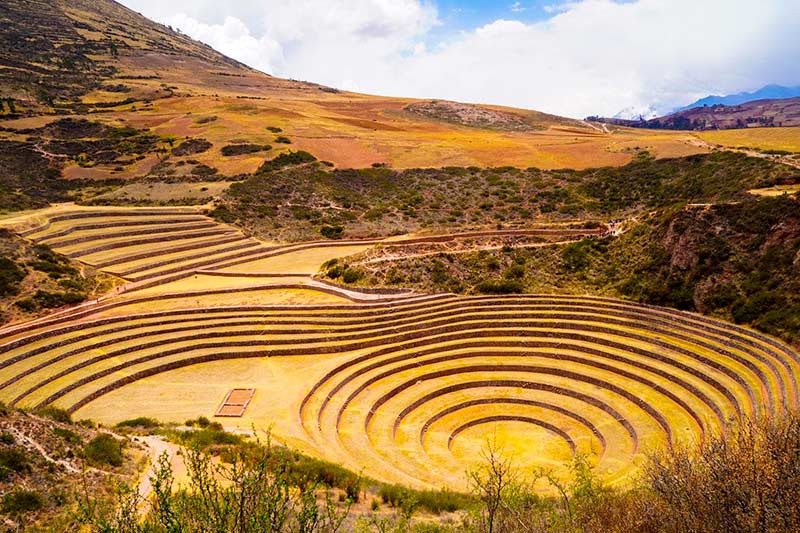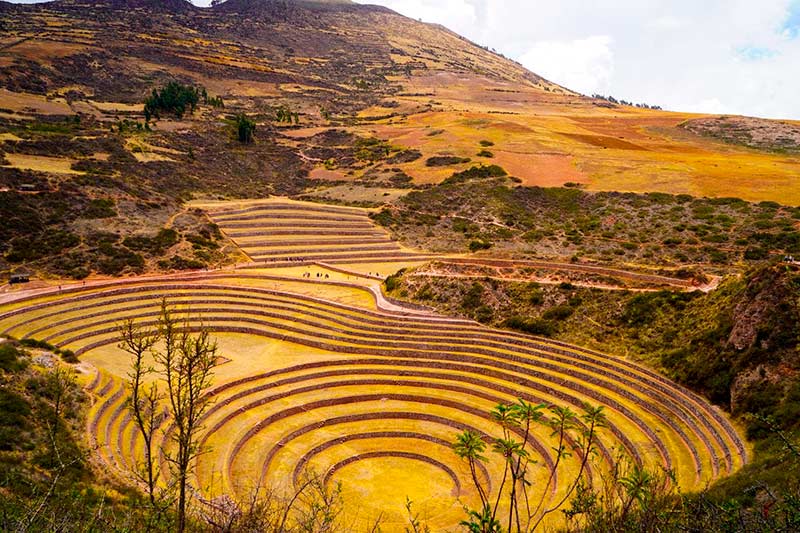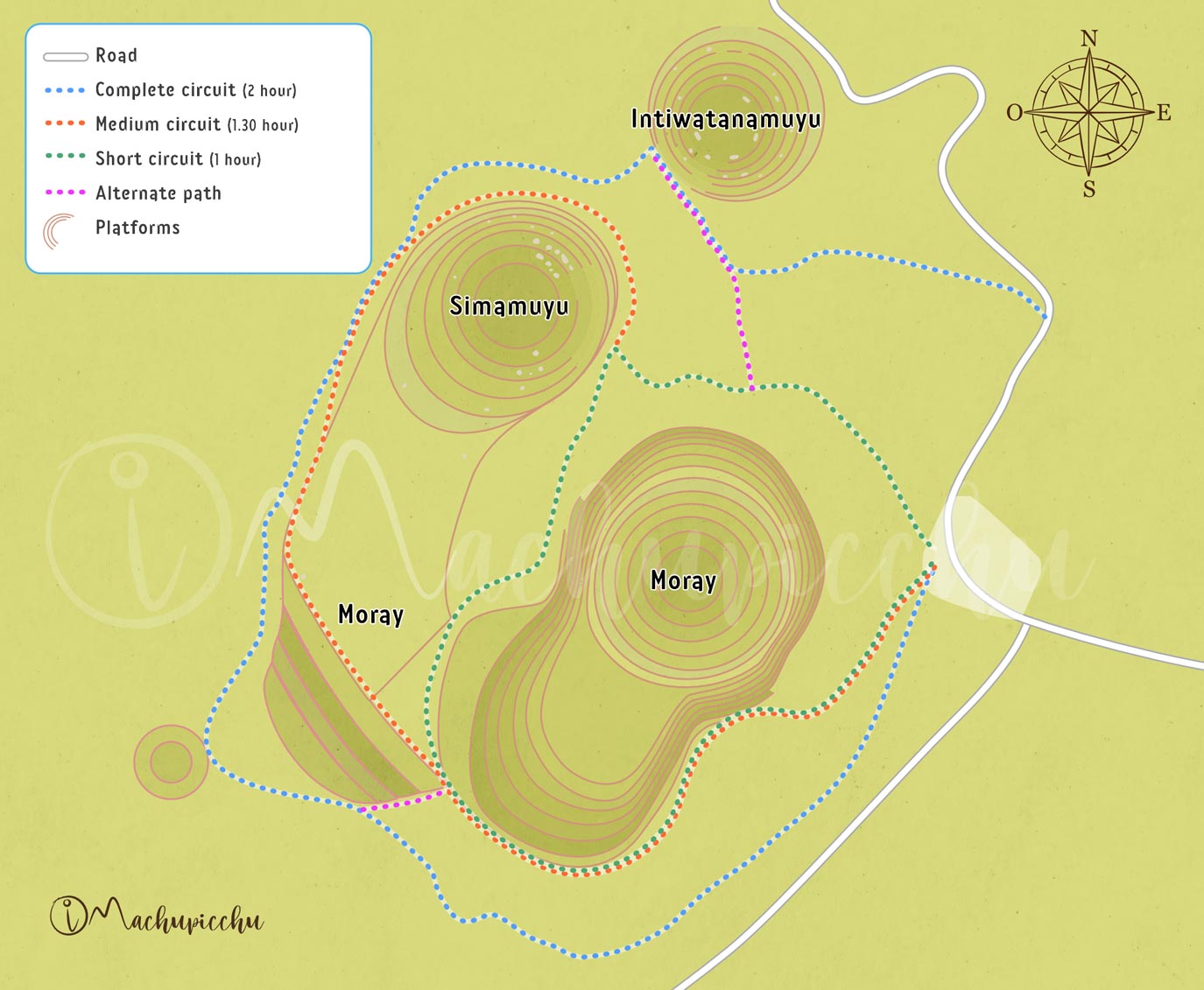Moray, circular platforms with microclimates
In the Sacred Valley of the Incas is the Moray archaeological site, a place with agricultural terraces that, at first glance, look like amphitheatres. These concentric terraces were built by the Incas as an agricultural laboratory. Each of its terraces has its own microclimate, according to the depth at which it is found. In total there are 3 circular complexes that are highly visited by tourists.
- Basic information about Moray: location, height
- The archaeological site of Moray
- Tourism in Moray: tickets, tours and tourist services
- Questions and answers about visiting Moray in Cusco
The Moray archaeological complex receives visitors every day of the year from 7 in the morning until 5 in the afternoon. The best way to visit Moray is with an organized tour that includes visits to the Maras salt mines. If you go on your own you can buy the Cusco Tourist Ticket for admission.
Basic information about Moray: location, height
Where is Moray located?
- The Moray archaeological group is located 7 kilometers from the town of Maras in the Sacred Valley of the Incas . You get there on a road trip from Cusco of approximately 50 kilometers. The altitude of the enclosure is 3,500 meters above sea level (11,482 ft).
- To get to Moray, you must follow a detour on the main road that connects Cusco and Urubamba. Although some people decide to go on their own, the best option is to get a tour package that includes transportation, tour guide and tickets.
Map from Cusco to Moray
What’s the meaning of your name?
- The word Moray would have different origins. In the Quechua language (language of the Incas) it means: a territory occupied since ancient times.
- Although the origin of the name of Moray is not known for certain, it is presumed that it had to do with the corn harvest called ‘Aymoray’, or with the month of May named in the same way by the Incas (sowing month in the calendar inca).
- Moray is also presumed to come from the name of the dehydrated potato known as the ‘moraya’ (white chuño) .
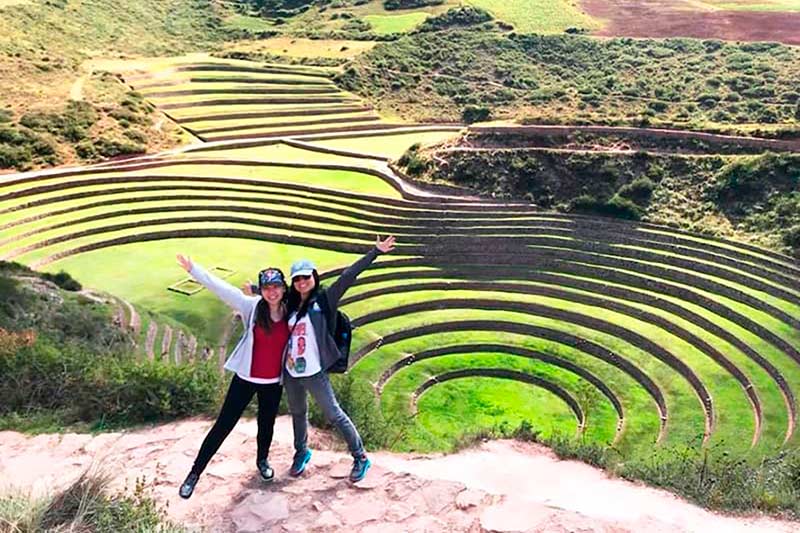
Moray
History of Moray
- Before the Incas, this part of the Sacred Valley of the Incas was inhabited by the ‘Maras’ and ‘Ayamarcas’ ethnic groups who occupied a large part of the current territory of the Sacred Valley of the Incas.
- After the Inca conquest, the construction of large buildings and platforms began in the territory of the Sacred Valley. Thus, the Moray platforms were built, which were used by the Incas as an important agricultural control center. There the production of the coca leaf was carried out, a plant considered sacred to the Incas .
- Investigations do not clearly indicate whether during the colony (from 1532) the Moray platforms were worked. The truth is that it was not until 1932 that the Shirppe Johnson’s expedition flew over the place, discovering the existence of the platforms, which were then covered by thick vegetation.
- During the 20th century, various investigations were carried out on Moray. Perhaps the most valuable of all was made by anthropologist John Earls who established that it was an experimental agricultural center .
How’s the weather?
- The climate in Moray is dry and temperate. The temperature varies from 21ºC. (69ºF). during the day until 1ºC. (33ºF). at night .
- From October to April the rainy season elapses where river precipitation is frequent. From May to September the dry season occurs where rains are not so frequent.
- April, May and June are believed to be the best time to visit Moray.
The archaeological site of Moray
What am I going to see in Moray?
- Beautiful landscapes – The set of platforms that make up Moray are visually beautiful to human eyes and, of course, in front of a camera lens. Many people come there to take their picture postcard and post it on their social networks.
- Circular platforms – The circular platforms of Moray were a very important place for Inca agriculture. It is believed that it was a center of experimental studies that the Incas used to plant products that, under other conditions, could not be cultivated.
- Adventure sports – There are tours to the Moray platforms that include adventure by bicycle or even ATV. These services can be obtained at any tourism agency located in the Historic Center of Cusco.
What was the function of the Moray terraces?
- According to research, during the Inca era of Tahuantinsuyo, Moray produced 60% of the total vegetable species as well as more than 3,000 varieties including potatoes, corn and many other species.
- For many years it was believed that Moray was caused by a meteorite that fell hundreds of years ago . However, the theory is currently accepted that suggests that it is an acclimatization and domestication center for various plant species that were adapted for human consumption.
- The main species of plant cultivated in Moray was the coca leaf, which is native to the hot regions of the Cusco jungle. The coca leaf was considered sacred by the Incas for its natural stimulating properties.
On the platforms that make up Moray, temperatures vary gradually from 20ºC. (68ºF). in the center (hottest) at 15ºC. (59ºF). on the upper terraces. Thus, more than 20 ecological zones were obtained with different altitude floors that are normally 1,000 meters (3,280 ft). below.
What products did they grow?
- In Moray each agricultural terrace (1.90 meters high) had a certain temperature. The deeper the temperature rose. Thus, the production of tubers was very varied.
- Among the products that were worked in Moray, the following stand out: potatoes, goose, quinoa, kiwicha, pumpkin, coca leaf and other herbs for medicinal use .
Tourism in Moray: tickets, tours and tourist services
How to go?
- With a tourist package – If you hire an all-inclusive tour, the tourist transport service to Moray is already included.
- On your own – To go to Moray on your own you must take a tourist transport to the town of Chinchero. From there you must take a transport to the town of Maras, from where other transport services depart to the circular platforms of Moray.
Tips for your visit
- If you travel on your own, buy the Cusco Tourist Ticket , which also includes a visit to the other tourist sites of the Sacred Valley of the Incas: Pisac, Chinchero and Ollantaytambo.
- In Moray it can rain at any time (especially from January to March), so it is advisable to bring a rain poncho.
Entrance fee to Moray
- The entrance ticket to Moray is with the so-called ‘Cusco Tourist Ticket’, which costs 70 soles for foreigners and 40 soles for Peruvians.
- This ticket also includes entry to the archaeological sites of Ollantaytambo, Pisac and Chinchero. Does not include entry to the Maras Salineras.
- The Cusco Tourist Ticket can be purchased at the entrance gate of the Moray archaeological site. Also in the offices of the city of Cusco on Avenida El Sol 103 (historic center of Cusco).
Price of a tour to Moray
You can visit Moray through these tours:
- Maras Tour – Moray half day – Tour that includes a visit to the town of Maras, the Salineras de Maras and the circular platforms of Moray. It lasts 6 hours, from 8 in the morning to 2 in the afternoon. It costs approximately 60 dollars per foreign tourist.
- Maras – Moray ATV Tour – Tour that includes a visit to the Maras salt mines and the circular platforms of Moray on an ATV adventure. It lasts 6 hours, from 8 in the morning to 2 in the afternoon. It costs approximately $66 per foreign tourist.
- VIP Sacred Valley Tour – Tour that includes a visit to the salt mines of Maras, the circular platforms of Moray, as well as the archaeological sites of Pisac, Ollantaytambo and Chinchero. Additionally, it includes a buffet lunch in Urubamba. It lasts 12 hours, from 7 in the morning to 7 at night. It costs approximately $80 per foreign tourist.
Budget to visit Moray with a tour or on your own
These are the differences between visiting Moray with a tour or on your own:
Moray on your own | Maras – Moray Tour | |
|---|---|---|
| Transport | Cusco – Chinchero – Moray route (round trip) 12 USD | Included in the tour (round trip) |
| Professional guide | Private service 15 USD | Included in the tour (group service) |
| Entrance | Cusco Tourist Ticket 20 USD | Included in the tour |
| Visit other nearby tourist attractions | Optional town of Maras and Salineras de Maras 12 USD | Included in the tour |
| Feeding | Optional | Optional |
| Final price | 59 USD | 60 USD |
What other places to visit?
- The town of Maras – The town of San Francisco de Asís de Maras is 39 kilometers from the city of Cusco. Its beautiful colonial church stands out with canvases created by painters from the famous ‘Cusco school’. From there, vehicles leave for Moray and the Maras salt mines.
- The Maras salt mines – The hundreds of natural salt wells that make up these salt mines are a sight to behold. It was used since the time of the Incas and continues to be marketed until today by the inhabitants of the place. The tours to Moray include visiting these salt mines and the town of Moray.
Moray customs
- Every October 8, hundreds of people who live in the neighboring communities of Moray attend the circular platforms in order to celebrate the ‘Moray Raymi’ or the ‘Fiesta de Moray’.
- This festivity includes a show of folk dances related to the land, production, harvesting and agricultural work .
- During that date, in addition to local people, dozens of tourists visit the Moray platforms to learn a little more about the Inca traditions represented there.
Questions and answers about visiting Moray in Cusco
1) How to go from Cusco to Moray?
Moray is located approximately 47 kilometers by road from the city of Cusco (1 hour 40 minutes of travel). You can go with a Maras – Moray tour (tourist transportation included) or on your own taking the Cusco – Chinchero – Maras – Moray route. The best option is to choose a tour.
2) How much does a tour to Moray in Cusco cost?
The Maras – Moray tour in half-day service costs approximately $60 per tourist ($45 for Peruvian tourists). Prices vary depending on the tourism agency of your preference.
3) When is the time when Moray looks its greenest?
During the rainy season (January, February and March), Moray offers its greenest landscapes, which helps to get the best photographs of the place.
4) Who built Moray?
Moray has a history that dates back to times before the Incas (probably from the time of the Ayamarcas’ and ‘Maras’. However, it was the Incas who perfected its platforms and terraces.
5) How much does the entrance fee to Moray cost?
Entry to Moray is included in the Cusco Tourist Ticket. This ticket costs 70 soles for foreign visitors and 40 soles for Peruvian visitors. Keep in mind that this tourist ticket also offers a visit to the archaeological sites of Pisac, Chinchero and Ollantaytambo.
6) What are the visiting hours to Moray?
El horario de visita a Moray es de 7 de la mañana hasta las 6 de la tarde. El sitio arqueológico está abierto todos los días, incluso domingos y feriados.
7) Can I enter the Moray platforms?
No, currently entry to the Moray platforms is prohibited. This to avoid the deterioration of their buildings.
8) How long does the Moray tourist circuit take?
The tourist circuit through the archaeological site of Moray takes approximately 1 hour. It includes a tour of the paths that surround the main platforms of Moray.
9) How high is Moray in Cusco?
The Moray archaeological site is located 3,500 meters above sea level (the city of Cusco is 3,399 meters above sea level).
10) What other tourist attractions to visit in Moray?
The main tourist attractions near Moray are the town of Maras and the Salineras de Maras. The first is famous for its arches and colonial buildings. The second for its hundreds of natural salt wells formed thousands of years ago.
Advice from people who have been there
 By: Magaly S
By: Magaly S“Discovering old research sites“
“I researched a lot before arriving in Moray and when I arrived I could check everything I had found, this place was an agricultural laboratory where the Incas experimented with all kinds of plants, it's great“
By Ticket Machu Picchu – Last updated, November 27, 2023
